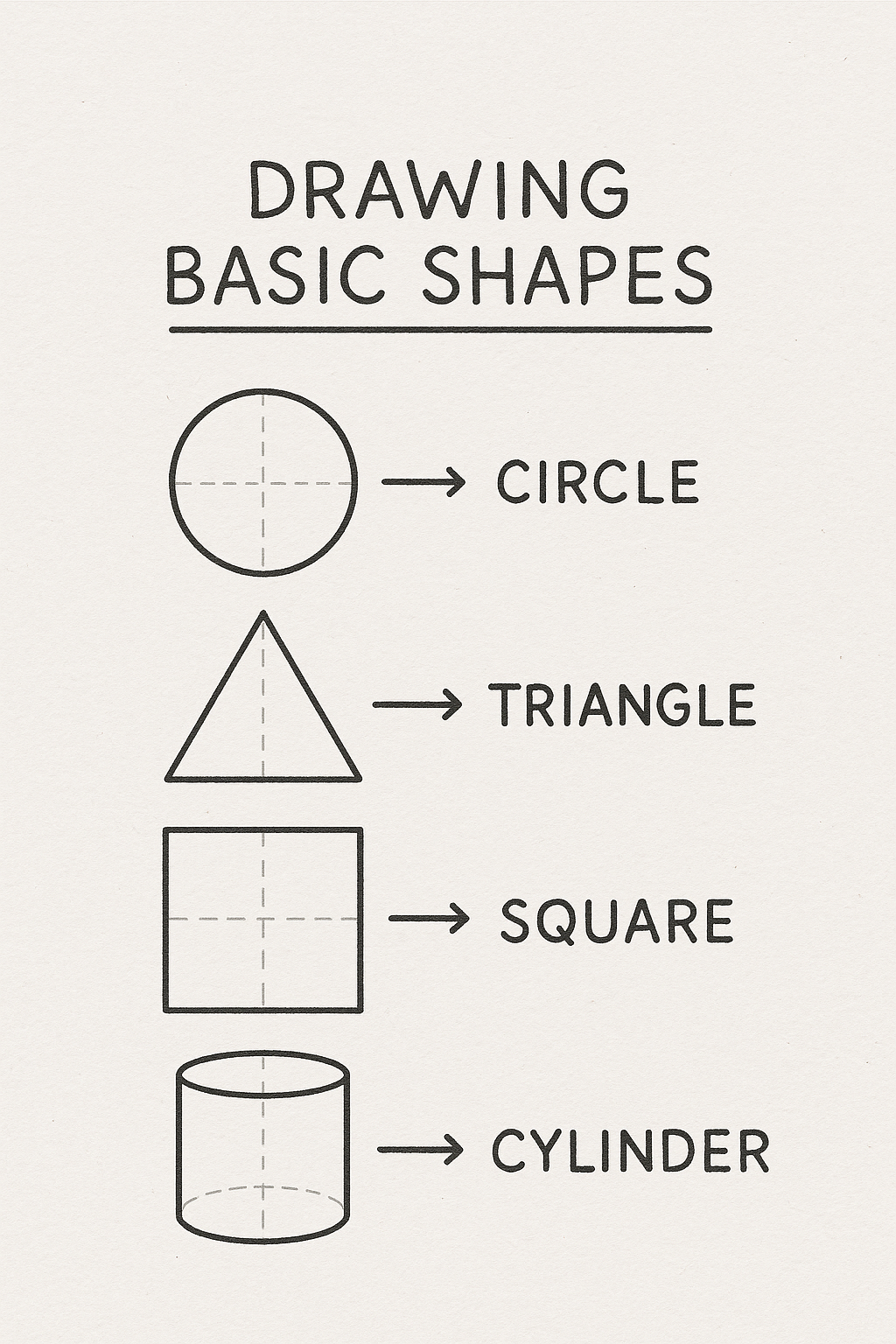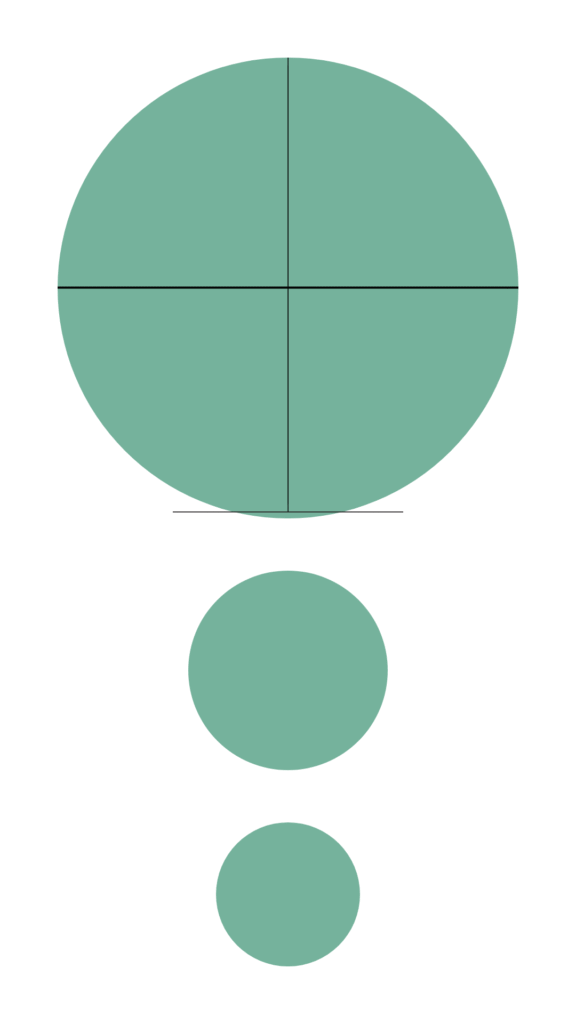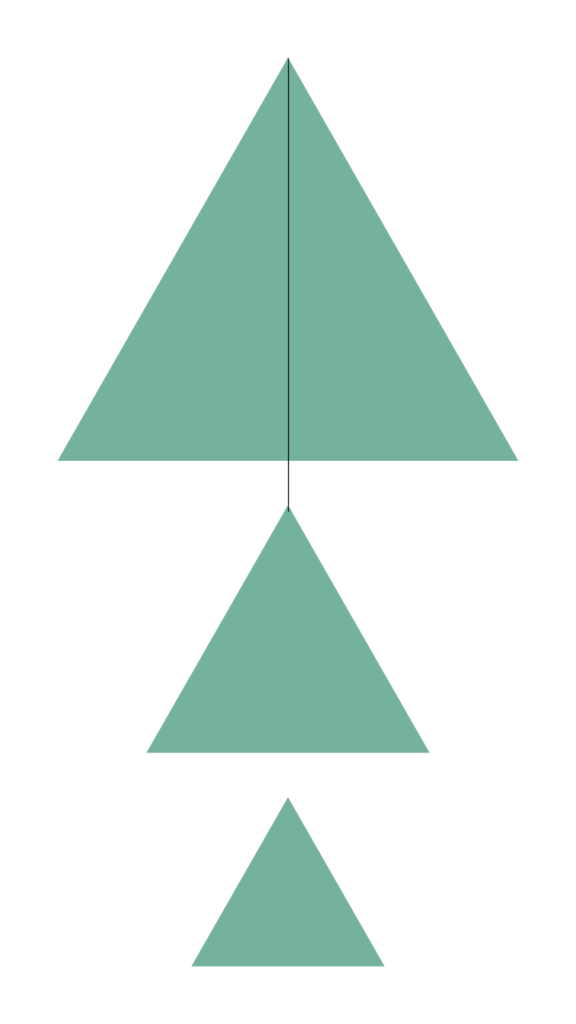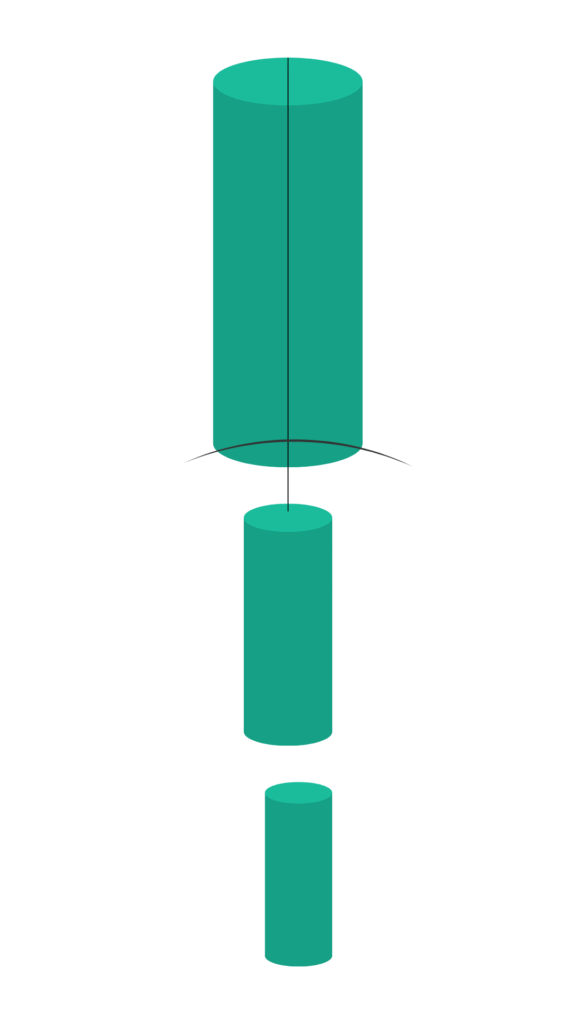Drawing basic shapes is the foundation of all artistic expression and technical drawing. Whether you’re just starting your artistic journey or looking to refresh your fundamentals, mastering these four essential shapes will unlock your ability to draw virtually anything. Every complex object can be broken down into these simple geometric forms, making them the building blocks of successful drawing.

Basic shapes drawing tutorial illustration showing circle, triangle, square, and cylinder
Why Basic Shapes Matter
Learning to draw simple shapes isn’t just about drawing geometric forms—it’s about developing the fundamental skills that underpin all drawing. These shapes serve as construction tools that help artists break down complex subjects into manageable parts. When you can confidently draw a circle, triangle, square, and cylinder, you can construct everything from a human face to architectural structures.
The ability to draw these shapes accurately also trains your hand-eye coordination, develops muscle memory, and improves your understanding of form and proportion. Professional artists regularly use these shapes as warm-up exercises and construction frameworks for their more complex artwork910.
Drawing Circles

The circle is often considered the most challenging basic shape to master, but with the right techniques, you can achieve smooth, confident circles.
The Shoulder Movement Technique
The key to drawing good circles is using your entire arm, not just your wrist. Lock your wrist and draw from your shoulder in a fluid, circular motion. Before putting pencil to paper, practice the circular movement in the air above your drawing surface.
The Square Method

One effective approach is to first draw a square, then inscribe the circle within it. Draw diagonal lines from corner to corner to find the center, then add vertical and horizontal guidelines. Use these reference points to guide your circle, ensuring it touches the midpoint of each square’s side.
The Rotating Paper Technique
A clever trick for perfect circles involves using your hand as a compass. Place your hand on the paper as an anchor point, hold your pencil steady, and rotate the paper with your other hand. This creates a perfect circle while keeping your drawing hand stationary.
Practice Tips for Circles
Start with smaller circles and gradually work up to larger ones, as bigger circles are more challenging. Draw multiple light circles in the same location, then choose the best line to emphasize. Practice drawing circles at different angles to create ellipses, which are essential for drawing cylindrical objects in perspective.
Drawing Triangles

Triangles are fundamental shapes that appear in countless objects and provide structural strength in both art and architecture.
Basic Triangle Construction
Start with three points that form your triangle’s corners11. The key challenge in drawing triangles is achieving equal sides and angles when desired. For equilateral triangles, use the compass and straightedge method: draw a baseline, then use a compass to create arcs from each endpoint that intersect above the line.
The Symmetry Check Method
For triangles that need to be symmetrical, draw a vertical line down from the apex that meets the base at a 90-degree angle. Measure the distance from this perpendicular line to each corner of the base—they should be equal for a symmetric triangle.
Drawing Triangles Freehand
When drawing freehand, focus on getting the general proportions right first11. Start with light construction lines, then refine the shape. Pay attention to the angles—they should add up to 180 degrees, with each angle appearing balanced for the triangle type you’re creating2223.
Drawing Squares and Rectangles
Squares and rectangles are among the most fundamental shapes in drawing, providing structure and stability to compositions.
The Parallel Lines Method
The most reliable approach is to draw two parallel horizontal lines first, then connect them with two parallel vertical lines. This ensures your angles remain close to 90 degrees and your opposite sides are equal.
Measuring for Accuracy
Use your pencil as a measuring tool by holding it at arm’s length. Mark the width with your thumb, then transfer that measurement to check that your square’s height matches its width. For rectangles, maintain consistent proportions by measuring and comparing dimensions.
Freehand Square Techniques
When drawing freehand squares, start with a rough rectangle, then use the pencil measuring technique to correct proportions. Mark equal measurements on all sides and adjust your lines accordingly. Remember that achieving perfect 90-degree angles freehand takes practice—focus on making them look square rather than geometrically perfect.
Drawing Cylinders

Cylinders combine the challenges of circles with the complexity of three-dimensional form, making them excellent practice for developing spatial awareness.
Basic Cylinder Construction
Start by drawing two ellipses—one for the top and one for the bottom of the cylinder. The top ellipse should appear smaller due to perspective. Connect these ellipses with straight vertical lines on the sides.
Understanding Ellipses in Cylinders
The key to convincing cylinders is understanding that circles become ellipses when viewed at an angle. The ellipse at the top of the cylinder will be narrower than the one at the bottom when viewed from above. The minor axis of each ellipse should be perpendicular to the cylinder’s central axis.
One-Sided vs. Two-Sided Cylinders
You can draw cylinders showing just one circular end (like looking straight at a can) or both ends (like looking at a tilted tube)26. For a one-sided cylinder, draw a rectangle and add a curved top. For a two-sided cylinder, show both elliptical ends with connecting sides2628.
Cylinder Variations
Practice drawing cylinders at different angles and proportions. Try creating cones by tapering one end to a point, or experiment with stretching and compressing your cylinders to create various forms. This flexibility will help you draw everything from bottles to architectural columns.
Fundamental Drawing Principles
Hand Position and Movement
Hold your pencil loosely, about an inch up from the tip, and draw from your shoulder rather than your wrist. This gives you better control over longer lines and smoother curves. Keep your wrist locked for most basic shape exercises.
Light Construction Lines
Always start with light, loose lines that you can easily erase or draw over. Build up your shapes gradually, refining them as you go. Don’t try to get the perfect shape on your first attempt—drawing is an iterative process.
Using Guidelines
Don’t hesitate to use construction lines, center points, and measuring techniques. Professional artists use these aids regularly, and they’ll help you develop accuracy that will eventually become intuitive.
Practice Exercises and Routines
Daily Warm-Up Routine
Spend 5-10 minutes each day drawing basic shapes as a warm-up. Draw circles of various sizes, practice straight lines for squares and rectangles, and work on ellipses for cylinder construction.
Progressive Difficulty
Start with smaller shapes and gradually increase size. Once you’re comfortable with individual shapes, try combining them to create simple objects. Practice drawing shapes from different viewpoints to understand how they appear in perspective.
Shape Combination Exercises
Try breaking down everyday objects into basic shapes. A house might be a triangle on top of a rectangle, while a bottle could be several cylinders of different sizes stacked together. This exercise trains you to see complex subjects as combinations of simple forms.
Common Mistakes and Solutions
Avoiding Flat Circles
Many beginners draw circles that are too flat or have pointed ends. Remember that circles maintain their curved nature throughout—avoid creating “almond” shapes when you mean to draw circles.
Square Corner Consistency
When drawing squares freehand, corners often become uneven. Use the measuring technique with your pencil to check that all sides are equal and angles are approximately 90 degrees.
Cylinder Perspective Errors
A common mistake is drawing cylinder ellipses as flat lines when viewed head-on. Even when looking directly at a cylinder’s end, you should still see a slight curve rather than a completely flat line.
Building Toward Complex Drawing
Once you’ve mastered these basic shapes, you’ll find that drawing complex subjects becomes much more manageable. Every animal, person, building, or object can be constructed using combinations of circles, triangles, squares, and cylinders as your foundation.
The confidence you gain from reliably drawing these simple shapes will translate into better proportion, improved spatial awareness, and stronger overall drawing skills. Remember that even master artists continue to practice these fundamentals throughout their careers—they are truly the foundation upon which all drawing skills are built.
Start with just a few minutes of practice each day, focusing on smooth, confident movements rather than perfect results. With consistent practice, these basic shapes will become second nature, opening up endless possibilities for your artistic development.
- https://artbyro.com/drawing-with-shapes/
- https://thevirtualinstructor.com/blog/drawing-basics-construction
- https://www.youtube.com/watch?v=9vK84953ivs
- https://www.youtube.com/watch?v=-6F5q_5HC3o
- https://www.youtube.com/watch?v=gMjpAYASbC8
- https://rapidfireart.com/2017/05/09/lesson-3-going-from-2d-to-3d-2/
- https://www.thebeginnerdrawingcourse.com/blogforartists/2020/7/19/drawing-exercises-for-beginners
- https://www.easydrawingtips.com/beginner-drawing-exercises-tutorial/
- https://www.youtube.com/watch?v=BKiopm83L8c
- https://www.youtube.com/watch?v=ahmqAhF5dhE
- https://www.youtube.com/watch?v=b45kVcG1RqQ
- https://www.youtube.com/watch?v=hsLkcgyfPGw
- https://www.youtube.com/watch?v=JEiLqbnSaWw
- https://drawpj.com/draw-perfect-circles-freehand/
- https://tatyanadeniz.com/circles/
- https://www.thepencilroomonline.com/articles/how-to-draw-circles-and-ellipses-freehand/
- https://www.reddit.com/r/learnart/comments/n9410x/how_do_you_draw_circles_freehand/
- https://www.craftsy.com/post/how-to-draw-3d-shapes
- https://learningmole.com/shape-construction-building-objects/
- https://testbook.com/maths/constructing-triangles
- https://byjus.com/maths/constructing-triangles/
- https://www.youtube.com/watch?v=NzcTKGxwCCE
- https://www.bbc.co.uk/bitesize/articles/zqw4wsg
- https://www.thedesignsketchbook.com/how-to-draw-perfect-square-the-common-mistakes-tip-151-video/
- https://www.youtube.com/watch?v=6xxmKp4TP7A
- https://www.youtube.com/watch?v=3g40StZfNbk
- https://www.youtube.com/watch?v=PdtDtGBu-Dc
- https://www.youtube.com/watch?v=_XJ1A5io8vc
- https://www.thedesignsketchbook.com/how-to-draw-100-forms-and-turn-them-into-products-cylinder-base/
- https://www.youtube.com/watch?v=r9IJW6O7RxM
- https://www.numberanalytics.com/blog/ultimate-guide-to-cylinders-in-drawing-for-beginners
- https://www.designreview.byu.edu/collections/learn-to-sketch-shading-and-shadowing-cylinders
- https://cravepainting.com/blog/15-minutes-drawing-exercise-routine
- https://www.youtube.com/watch?v=9hz_GX0eD5w
- https://www.pinterest.com/pin/how-to-draw-a-design-of-circle-square-and-triangle-coloring-with-marker-pen-step-by-step-very-easy-youtube–726205508660806808/
- https://www.youtube.com/watch?v=ekG9D20MOoI
- https://juliabausenhardt.com/how-to-draw-anything-learn-sketching-for-beginners/
- https://www.youtube.com/playlist?list=PLDcVY7tIUDzsNR5AjIzqyiN2P85TKAWvb
- https://www.youtube.com/watch?v=Dg5sNfwWXdM
- https://www.youtube.com/watch?v=9m4Hf_6U4Rc
- https://tex.stackexchange.com/questions/188533/how-to-draw-squares-circles-and-triangles
- https://www.youtube.com/watch?v=jlzX8jt0Now
- https://www.pinterest.com/a0511390/basic-shapes/
- https://www.youtube.com/watch?v=USIQ-DN15Oo
- https://www.youtube.com/watch?v=bUS-NASiYCs
- https://www.theteachertoolkit.com/index.php/tool/triangle-square-circle
- http://help.sketchup.com/en/sketchup/drawing-lines-shapes-and-3d-objects
- https://lundgrenart.weebly.com/drawing-simple-shapes.html
- https://www.youtube.com/watch?v=4Y9A1dv0kEM
- https://www.pinterest.com/pin/drawing-and-shading-cylinders–544443042423263552/
- https://www.youtube.com/playlist?list=PLGxYpUgtoNej6EyKHPedkfAQ2q7DeHgOT
- https://www.youtube.com/watch?v=40SUfZfpznY
- https://byjus.com/maths/construction-of-triangles/
- https://www.youtube.com/watch?v=js03PX82huk
- https://www.youtube.com/shorts/ip8cRukmyjE
- https://thirdspacelearning.com/gcse-maths/geometry-and-measure/constructing-triangles/
- https://www.shihoriobata.com/blog/easy-square-rectangle-drawing-ideas/
- https://www.youtube.com/watch?v=eAhfZUZiwSE
- https://www.youtube.com/watch?v=DTcuKjlz5zE
- https://www.youtube.com/watch?v=qQ9LRsU8Mfs
- https://www.youtube.com/playlist?list=PL4RPz8RY0GsP9_9LVNStY6eKU5uESu37U
- https://www.andrew.cmu.edu/user/ramesh/pub/distribution/journal/epb080005-constructionOfShapes.pdf
- https://in.pinterest.com/ramyadatta9/drawing-excercise/
- https://www.geeksforgeeks.org/ssc-banking/shape-construction/
- https://drawabox.com
- https://www.mathsisfun.com/geometry/constructions.html
- https://www.reddit.com/r/learntodraw/comments/rroowb/how_do_i_get_better_at_drawing_simple_shapes/
- https://www.youtube.com/watch?v=2aRd0QnP7Is
